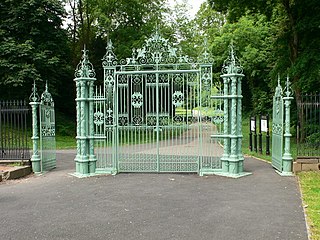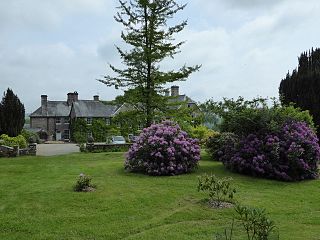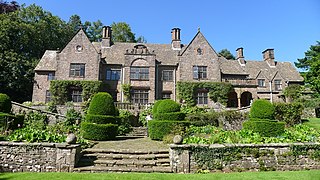
Pontypool Park is a 150-acre (0.61 km2) park in Pontypool, Torfaen, Wales. The park was formerly the grounds of Pontypool House and was laid out in the closing years of the 17th century for John Hanbury, an ironmaster, who is closely associated with Japanware. The grounds were purchased by the local authority in 1920, while the estate house was leased, and later sold, to the Sisters of the Holy Ghost to become St. Alban's RC High School. The former stables now house the Torfaen Museum. The grounds contain a number of structures including a double ice house, the Folly Tower and the Shell Grotto. The park is entered through the Pontymoile Gates. The gates, the grotto and the stables are all Grade II* listed structures, while the former hall and the ice house are listed Grade II. The park itself is designated at Grade II* on the Cadw/ICOMOS Register of Parks and Gardens of Special Historic Interest in Wales.

The Hendre, in Rockfield, is the only full-scale Victorian country house in the county of Monmouthshire, Wales. The ancestral estate of the Rolls family, it was the childhood home of Charles Rolls, the motoring and aviation pioneer and the co-founder of Rolls-Royce. Constructed in the Victorian Gothic style, the house was developed by three major architects, George Vaughan Maddox, Thomas Henry Wyatt and Sir Aston Webb. It is located in the civil parish of Llangattock-Vibon-Avel, some 4 miles (6.4 km) north-west of the town of Monmouth. Built in the eighteenth century as a shooting box, it was vastly expanded by the Rolls family in three stages during the nineteenth century. The house is Grade II* listed and is now the clubhouse of the Rolls of Monmouth Golf Club. The gardens and landscape park, mainly laid out by Henry Ernest Milner in the later 19th century, are designated Grade II* on the Cadw/ICOMOS Register of Parks and Gardens of Special Historic Interest in Wales.

Llangattock-Vibon-Avel is a rural parish and former community, now in the community of Whitecastle in Monmouthshire, south-east Wales, in the United Kingdom. It is located 5 miles (8.0 km) west of Monmouth and some 13 miles (21 km) east of Abergavenny, just off the B4233 old road between the two. Villages within the former community include Llangattock itself, Skenfrith, Rockfield, and Newcastle.

A memorial statue to the aviation pioneer Charles Rolls stands in front of the Shire Hall in Agincourt Square, Monmouth, Wales. The 8 feet (2.4 m) high bronze statue was designed by Sir William Goscombe John, R.A. and Sir Aston Webb, R.A. designed the pink granite plinth. The statue is a Grade II* listed structure.

George Vaughan Maddox was a nineteenth-century British architect and builder, whose work was undertaken principally in the town of Monmouth, Wales, and in the wider county. Working mainly in a Neo-Classical style, his extensive output made a significant contribution to the Monmouth townscape. The architectural historian John Newman considers that Monmouth owes to Maddox "its particular architectural flavour. For two decades from the mid-1820s he put up a sequence of public buildings and private houses in the town, in a style deft, cultured, and only occasionally unresolved." The Market Hall and 1-6 Priory Street are considered his "most important projects".

Llanarth Court is a late-18th-century country house with substantial 19th-century alterations in Llanarth, Monmouthshire, Wales. The court was built for the Jones family of Treowen and was subsequently the home of Ivor Herbert, 1st Baron Treowen, whose family still owns much of the Llanarth estate, although not the court itself. The court is a Grade II* listed building and is now a private hospital. The gardens are included on the Cadw/ICOMOS Register of Parks and Gardens of Special Historic Interest in Wales.

Clytha Park, Clytha, Monmouthshire, is a 19th-century Neoclassical country house, "the finest early nineteenth century Greek Revival house in the county." The wider estate encompasses Monmouthshire's "two outstanding examples of late eighteenth century Gothic", the gates to the park and Clytha Castle. The owners were the Jones family, later Herbert, of Treowen and Llanarth Court. It is a Grade I listed building.

LlanvihangelCourt, Llanvihangel Crucorney, is a Tudor country house in Monmouthshire, Wales. The architectural historian John Newman, in his Gwent/Monmouthshire volume of The Buildings of Wales series described the court as "the most impressive and richly decorated house of around 1600 in Monmouthshire". The origins of the house are medieval, with a traditional date of construction of 1471. The building was given its present appearance by a substantial enlargement and re-casing of circa 1600 by Rhys Morgan, of the family of the original owners. In the very early 17th century it was owned briefly by Edward Somerset, 4th Earl of Worcester.

The Argoed, Penallt, Monmouthshire, Wales, is a Victorian country house dating from the 1860s, with earlier origins from the late 16th and early 17th centuries. It is a Grade II* listed building and the garden is listed on the Cadw/ICOMOS Register of Parks and Gardens of Special Historic Interest in Wales. The English meaning of the Welsh word argoed is 'by a wood'.

High Glanau is a country house and Grade II* listed building within the community of Cwmcarvan, Monmouthshire, Wales. It is located about 5 miles (8.0 km) south-west of Monmouth, and 1.5 miles (2.4 km) north of Trellech, adjoining the B4293 road and with views westwards over the Vale of Usk. Commissioned by Henry Avray Tipping and designed by Eric Francis, it is particularly noted for its gardens which are listed at Grade II* on the Cadw/ICOMOS Register of Parks and Gardens of Special Historic Interest in Wales.

Kingsley House and Hendre House are a pair of 19th-century, semi-detached houses on the North Parade section of Monk Street in Monmouth, Monmouthshire, Wales. The grade II listed houses were designed by noted Monmouth architect and builder George Vaughan Maddox, who also designed at least two of the twenty-four blue plaque buildings on the Monmouth Heritage Trail, including the Market Hall and the Monmouth Methodist Church. Hendre House should be distinguished from The Hendre, the estate of the Rolls family.

Wyndcliffe Court, 0.5 miles (0.80 km) north of the village of St. Arvans, Monmouthshire, Wales, is a Grade II* listed country house and gardens in the Arts and Crafts style, completed in 1922. The client was Charles Leigh Clay and the architect Eric Francis. The gardens were designed by Henry Avray Tipping and are included on the Cadw/ICOMOS Register of Parks and Gardens of Special Historic Interest in Wales.

Monmouthshire is a county of Wales. It borders Torfaen and Newport to the west; Herefordshire and Gloucestershire to the east; and Powys to the north. The largest town is Abergavenny, with the other major towns being Chepstow, Monmouth, and Usk. The county is 850 km2 in extent, with a population of 95,200 as of 2020. The present county was formed under the Local Government (Wales) Act 1994, which came into effect in 1996, and comprises some sixty percent of the historic county. Between 1974 and 1996, the county was known by the ancient title of Gwent, recalling the medieval Welsh kingdom. In his essay on local government in the fifth and final volume of the Gwent County History, Robert McCloy suggests that the governance of "no county in the United Kingdom in the twentieth century was so transformed as that of Monmouthshire".

Mounton House, Mounton, Monmouthshire, Wales, is the last major country house built in the county, constructed between 1910 and 1912 by the architect and writer Henry Avray Tipping for himself. Formerly a school, which has now relocated to the grounds, the house has been divided into apartments. It is a Grade II* listed building. The surrounding park is on the Cadw/ICOMOS Register of Parks and Gardens of Special Historic Interest in Wales.

St Cenedlon's is a parish church in the village of Rockfield, Monmouthshire, Wales. The dedication to St Cenedlon is unusual and the history of the saint is obscure. Some sources suggest that she was a daughter of Brychan king of Brycheiniog while others identify her as the wife of King Arthfael ab Ithel, king of Glywysing. The existing church dates from the Middle Ages but only the tower remains from that period. After the English Reformation, the surrounding area of north Monmouthshire became a refuge for Catholics and Matthew Pritchard (1669-1750), Roman Catholic bishop and Vicar Apostolic of the Western District is buried at the church. By the mid-19th century the church was in ruins and a complete reconstruction was undertaken by the ecclesiastical architects John Pollard Seddon and John Prichard in around 1860. St Cenedlon's is an active parish church in the Diocese of Monmouth. It is designated by Cadw as a Grade II listed building.

The Church of St Cadoc, Llangattock Vibon Avel, Monmouthshire is a parish church of medieval origins which was heavily restored in the 19th century. The estate church of The Hendre, it is closely connected with the Rolls family and the grave of Charles Stewart Rolls, the motoring and aviation pioneer, is located in the churchyard. The church is a Grade II* listed building and is now in the care of the Friends of Friendless Churches.

The Old Cottage, in the hamlet of Treadam, some 2km north-west of Llantilio Crossenny, Monmouthshire, is a country house dating from c.1600. The house is Grade II* listed.

Maerdy Farmhouse (The Maerdy), Llanvihangel-Ystern-Llewern, Monmouthshire is a farmhouse dating from about 1700. Extended later in the 18th century, it is an early example of the use of brick, rather than stone, in Monmouthshire. The farmhouse is Grade II* listed with its stableblock and shelter shed, and its barn and cider house having their own Grade II listings.

Trivor Farmhouse, St Maughans, Monmouthshire is a house dating from the late 17th century. Extended and reconstructed in the 18th century, it was originally the home of the recusant James family. In the 19th century it was bought by the Rolls family of the nearby Hendre estate. The house is Grade II* listed.

Monmouthshire is a county and principal area of Wales. It borders Torfaen and Newport to the west; Herefordshire and Gloucestershire to the east; and Powys to the north. The largest town is Abergavenny, with other large settlements being Chepstow, Monmouth, and Usk. The present county was formed under the Local Government (Wales) Act 1994, which came into effect in 1996. It has an area of 850 km2 (330 sq mi), with a population of 93,200 as of 2021. Monmouthshire comprises some sixty per cent of the historic county, and was known as Gwent between 1974 and 1996.


















